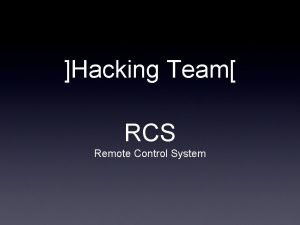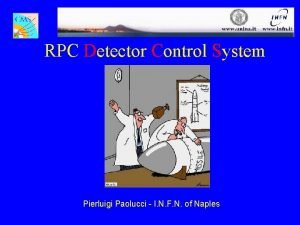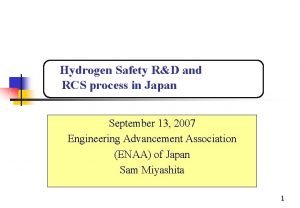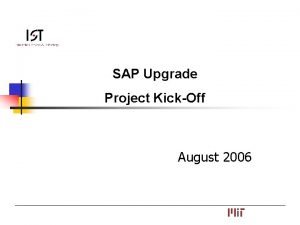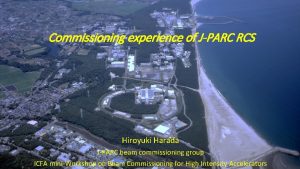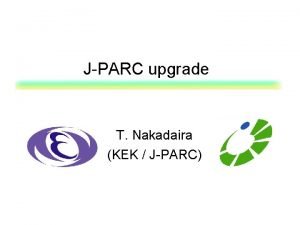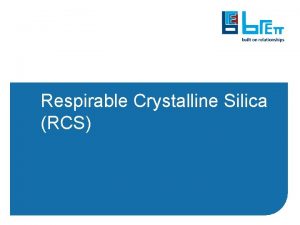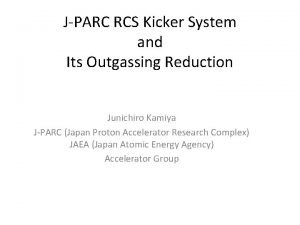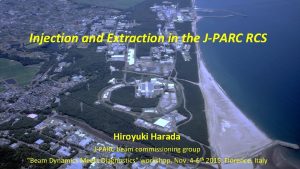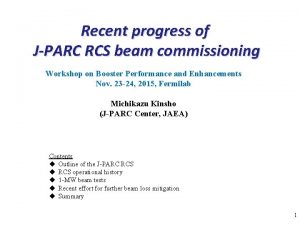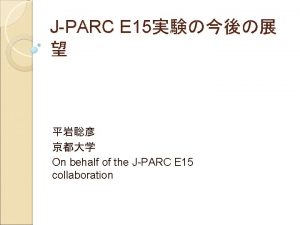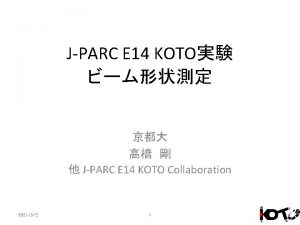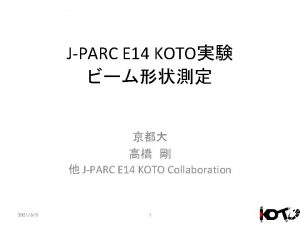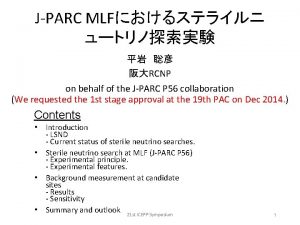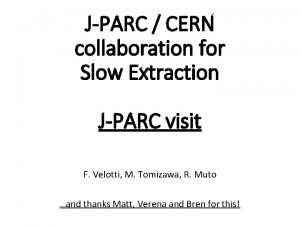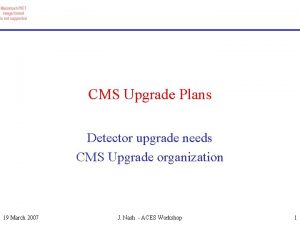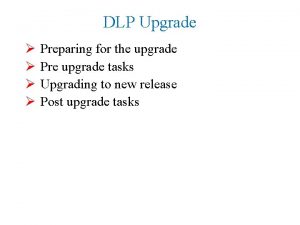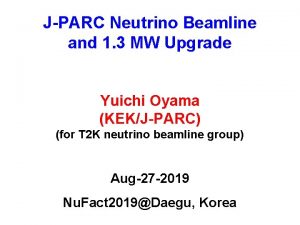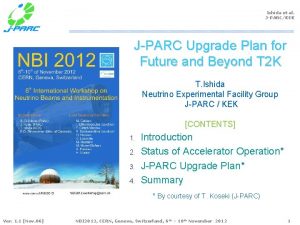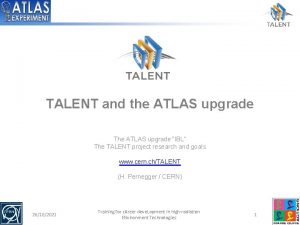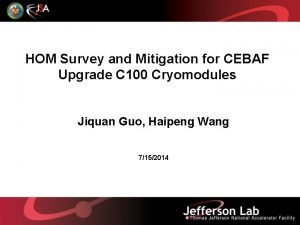Mitigation for JPARC Upgrade RCS and MR Mitigation



























- Slides: 27

Mitigation for J-PARC Upgrade: RCS and MR Mitigation Approaches for Hadron Storage Rings and Synchrotrons 2020/6/29 Susumu Igarashi KEK/J-PARC Center 1

Contents • • • Overview of the J-PARC Operation status for the fast extraction of MR Beam tuning Upgrade plan Summary 2

Japan Proton Accelerator Research Complex • High Intensity Proton Accelerators • Main Ring (MR) (30 Ge. V) • LINAC (400 Me. V) • Rapid Cycling Synchrotron • Facilities to use the secondary beams – Neutrino Facility • Operated by Japan Atomic Energy Agency (RCS) (3 Ge. V) – Hadron Hall • Materials and Life (JAEA) and High Energy Accelerator Science Experimental Research Organization (KEK) Facility (MLF) MR Hadron Hall RCS LINAC MLF Neutrino 3

Tokai to Kamioka (T 2 K) Long Baseline Neutrino Oscillation Experiment • CP Asymmetry Measurement • For observed imbalance of matter and antimatter abundance in the Universe • First 3σ constraint on the Leptonic mixing parameter δCP → published in Nature • Indicated CP violation at 2σ. (by excluding the CP symmetry sinδCP = 0 with 2σ. ) • T 2 K demands larger dataset for more precise measurement and search for new physics. 50 kton Nature April 2020 MR Far Detector Upgrade 2027 Neutrino J-PARC MR Beam Power Upgrade 500 k. W ➡� 1. 3 MW 4

MR Design and Operation Modes • Circumference 1567. 5 m • Three-fold symmetry • Original Design Beam Power: 750 k. W • Large Aperture • Beam Loss Localization • Imaginary Transition �� Lattice • Fast extraction mode (FX) for the neutrino Facility: 1 turn extraction. • Slow extraction mode (SX) for the hadron hall: 2 s – spill extraction. FX (2. 48 s) SX (5. 2 s) 5

MR Beam Power History • The beam power is ~ 500 k. W for the recent FX operation. • The beam power of ~ 50 k. W for the recent SX operation and 63 k. W was demonstrated. The target capacity limited the SX operation beam power. During the last shutdown, it was upgraded from 57 k. W to 95 k. W. FX SX 6

Contents • • • Overview of the J-PARC Operation status for the fast extraction of MR Beam tuning Upgrade plan Summary 7

Typical Operation Status for FX • Power : 515 k. W • Repetition : 2. 48 sec • 4 batch (8 bunch) injection during the period of 0. 13 s • 3. 4 e 13 protons per bunch (ppb) × 8 @ Injection • 2. 66 e 14 ppp @ P 3 (end of acceleration) • Beam Loss : 800 W • Loss power is within the MR collimator limit of 2 k. W • Loss at 3 -50 BT : 100 W, < 3 -50 BT collimator limit of 2 k. W Beam Intensity with DCCT Time (s) Injection Acceleration 0. 01 + 0. 13 s 1. 4 s Extraction Recovery 0. 94 s 8

Beam Loss Localization with Collimators • Four collimators and 3 absorbers are in operation with the total capacity of 2 k. W. • Beam losses are mostly localized at the collimator section. • Hands-on maintenance is possible with minimum exposure of residual radiation. Beam Loss Distribution Monitor sensitivity× 8 MR address Time (s) Collimator MR address Collimator system 9

Contents • • • Overview of the J-PARC Operation status for the fast extraction of MR Beam tuning Upgrade plan Summary 10

−ν νx 2 νx− νx+ 2νy =6 4 νy=21 21. 0 42 y= +ν 2νx=43 21. 5 21. 0 νx - Simulation based on the measured transverse emittances and bunching factor 21 − νy= 3νx=64 • MR Power 500 k. W • Space Charge Tune Shift: 0. 4 2νy=43 21. 5 νx=21 • RCS parameters optimization for the injection beam • 2 nd harmonic RF • Optics measurements and corrections • Third order resonance corrections • Transverse instability suppression • Longitudinal coupled bunch instability suppression y= 0 Tunings for the Beam Loss Reduction 11

RCS Tuning for MR beam Requirements for the beam operation to the MR l MR requires a low emittance beam with less beam halo to minimize beam loss at the MR. Tuning Parameters • Transverse injection painting : 50π mm mrad • Longitudinal injection painting : momentum offset − 0. 2 % • 2 nd harmonic RF V 2/V 1 = 70 % • Sextupole field : Small chromatic tune spread (ξx, ξy) ≅ (− 5, − 4) for t < 4 ms Instability suppression (ξx, ξy) ≅ (− 12, − 8) for t > 10 ms 12

RCS Tuning for MLF beam Requirements for the beam operation to the MLF l Sufficient beam loss mitigation is required for the reduction of the RCS machine activation. l MLF requires a wide-emittance beam to mitigate a shockwave on the neutron production target. ü By introducing pulse-by-pulse parameter switching, we successfully met the requirements from both MLF and MR while keeping the RCS beam loss within acceptable levels. Tuning Parameters • Transverse injection painting : 200π mm mrad • Longitudinal injection painting : momentum offset − 0. 1 % • 2 nd harmonic RF V 2/V 1 = 70 % • Sextupole field : 3 rd order resonance correction ( t< 6 ms ) Circulating beam intensity Tune diagram (6. 46, 6. 32) @ inj. x 1013 from injection to extraction 2 nx-2 ny=0 nx-2 ny=-6 2 nx=13 Flat! Intensity Vertical tune ny (6. 37, 6. 35) @ ext. 3 nx=19 Horizontal tune nx Time (ms) 13

2 nd Harmonic RF Operation Fundamental 100 k. V 2 nd harmonic 0 k. V Bunching factor 0. 2 ~ 0. 3 Bunch length ~200 ns Simulation (100 k. V, 0 k. V) RF Pattern for operation: Injection : 160 k. V (fundamental) 110 k. V (2 nd harmonic) Acceleration : 310 k. V → 256 k. V (fundamental) Fundamental 100 k. V 2 nd harmonic 70 k. V Bunching factor 0. 3 ~ 0. 4 Bunch length ~400 ns Simulation (100 k. V, 70 k. V) 14

Beta Measurement and Correction • Leak field of 8 FX septum magnets corresponds to ~3% of K 1 of the main Q magnet. • Beta at each BPMs was measured from the amplitude of betatron oscillation which is induced with the exciter. • Modulations were observed for both horizontal and vertical beta during injection and in the beginning of acceleration. • Correction with the trim coils of QFR 154, QDT 155 and QFP 156 was optimized. 15

3 rd Order Resonances Corrections with Trim Coils of Sextupole Magnets • νx+2νy=64 , (1+2) • Beam survival recovers with SFA 048: +0. 5 A, SFA 055: +0. 2 A. • |G| = 0. 076 • 3νx=64 , (3+0) • Beam survival recovers with SFA 048 +0. 5 A, SFA 055 0. 0 A. • |G| = 0. 055 • Simultaneous equations for 4 sextupole trim coils to correct both resonances. Injection Acceleration 16

Suppression of the Transverse Beam Instabilities • Transverse instabilities are being observed during the injection and acceleration period. • Negative chromaticity is applied for the instability suppression. Typically − 7 during injection. • Intra-bunch feedback system are applied during injection and up to 0. 12 s after the beginning of acceleration. Beam Position with Intra-bunch FB off Intra-bunch feedback system Beam Position with Intra-bunch FB on 2. 1 e 13 ppb × 2 bunches P 1+100 ms P 2 17

Suppression of the Coupled Bunch Instability with New RF Feedback System • Wake fields of undesired h=8 and 10 induced by the high intensity beam caused the coupled bunch instability. • It resulted in the beam losses during acceleration in the worst cases. • With the new RF feedback system, we were able to suppress the wake voltages of harmonics of h=8 and 10. RF Harmonics: 9, Number of Bunches: 8 Bunch Oscillation of 480 k. W beam without FB Bunch Oscillation of 480 k. W beam with FB 18

Contents • • • Overview of the J-PARC Operation status for the fast extraction of MR Beam tuning Upgrade plan Summary 19

Concept of the Upgrade Plan Beam Power Cycle Time Number of accelerated protons Present 500 k. W 2. 48 s 2. 6× 1014 ppp Original Design 750 k. W 1. 32 s 2. 1× 1014 ppp New Plan 1. 3 MW 1. 16 s 3. 3× 1014 ppp • For the Beam power upgrade of 500 k. W ➝ 1. 3 MW • Factor of 2 by faster cycling • ~30% gain by intensity increase 20

Mid-term Plan of MR • FX: Faster cycling: 2. 48 s ➝ 1. 32 s for 750 k. W, ➝ 1. 16 s for 1. 3 MW • SX: Mitigation of the residual radiation for 100 k. W JFY Event 2017 2018 Cycle time of main magnet PS New magnet PS Injection system FX system 2022 2023 2024 Long shutdown 500 50 500 70 >700 > 80 800 > 80 900 > 80 2. 48 s 2. 48 s 1. 32 s <1. 32 s Mass production/installation/test Manufacture, installation/test Capacity 2 k. W Capacity 3. 5 k. W Kicker PS improvement, Septa manufacture /test Kicker PS improvement, FX septa manufacture /test SX collimator / Local shields Ti ducts and SX devices with Ti chamber 2021 475 50 High gradient rf system 2 nd harmonic rf system Ring collimators 2020 HD target New buildings FX power [k. W] SX power [k. W] 2019 Local shields Ti-ESS-1 21

New Power Supplies being Constructed • New power supplies were designed for the faster cycle. • The electric power supplier did not allow us a large power variation by the faster cycle. • We decided to have capacitor banks for the energy recovery. • Power supplies for 4 out of 6 BM families were constructed by the end of JFY 2019. • Power supplies for the rest of BM families and some QM families will be constructed in JFY 2020. Capacitor Banks for BM 3_A BM 3_B BM 3_C New PS for BM 3 Choppers + Output filters 22

Installation Plan for RF Cavities • Higher RF voltages are necessary for the faster cycling. • The following numbers of RF cavities are necessary for the operation of 1. 32 s and 1. 16 s. • Upgrade of the anode power supplies are planned for the beam loading compensation. 2019 2020 202 X 2. 48 s 1. 32 s 1. 16 s FT 3 L 4 GAP Cavities 7 9 11 2 nd Harmonic Cavities 2 2 2 Accelerating Voltage 300 k. V 510 k. V 600 k. V 2 nd Harmonic Voltage 110 k. V Insertion C Ins A: 2 2 nd harmonic cavities Ins B: 2 fundamental cavities Ins C: 9 fundamental cavities MR Cycle Cavities at MR Insertion C 23 RCS RF Anode power supply

MR FX Beam Power Projection ③ RF system upgrade ① Magnet PS upgrade 2. 48 s ➝ 1. 32 s cycle ② 2 nd harmonic RF cavities ④ 1. 32 s ➝ 1. 16 s cycle 24

νx− 2νy = − 21 Resonance Correction • To achieve higher-intensity acceleration, further reduction of the beam loss is required. • The resonance amplitude G 1, -2 can be minimized with the optimized phase advance in the arc modules. • The beam study is necessary. Simulation without 1− 2 Resonance Correction Beam Survival Simulation with 1− 2 Resonance Correction Injection Acceleration Injection 25 Acceleration

Space Charge Simulation for New Operation Working Points • New operation working points have been searched for 1. 3 MW equivalent beam. • Beam survivals at (21. 40, 20. 45), (22. 20, 19. 40) and (22. 18, 22. 40) were better than that at (21. 35, 21. 45). • Beam study is necessary. Injection Acceleration 26

Summary • Beam power of 500 k. W has been achieved for MR FX operation with the following tunings. • • Injection beam optimization with the RCS parameters. RF operation with 2 nd harmonic and the new feedback system. Corrections of the beta modulation and resonances. Transverse instabilities are suppressed with the chromaticity settings and intrabunch feedback systems. • Beam power of 1. 3 MW is planned for MR with • The faster cycling : 2. 48 s → 1. 16 s • The accelerated protons : 2. 6× 1014 ppp → 3. 3× 1014 ppp. • Upgrades are necessary for the beam power of 1. 3 MW. • • Main magnet power supply RF Injection and extraction devices Collimators / Beam Abort Dump Monitors Control Further beam study. 27
 Rcs remote control systems
Rcs remote control systems Inspire rcs
Inspire rcs Rcs electronic control schema elettrico
Rcs electronic control schema elettrico Rcs japan
Rcs japan Urgent care rcs
Urgent care rcs Rcs demo
Rcs demo Rcs+
Rcs+ Laptop repair rensselaer
Laptop repair rensselaer Upgrade 2003 to 2008
Upgrade 2003 to 2008 Database upgrade project plan
Database upgrade project plan Visio 2010 trial
Visio 2010 trial Upgrade image quality
Upgrade image quality Rhel 6 to 7 upgrade
Rhel 6 to 7 upgrade Remedy upgrade
Remedy upgrade Cisco ise upgrade readiness tool
Cisco ise upgrade readiness tool Cisco output interpreter
Cisco output interpreter What are vue vip seats
What are vue vip seats Caloundra bruce highway upgrade
Caloundra bruce highway upgrade Upgrade windows 7 to windows 10
Upgrade windows 7 to windows 10 Lwapp to autonomous
Lwapp to autonomous Past perfect simple
Past perfect simple Getting a license illegally may result in
Getting a license illegally may result in Gfs upgrade
Gfs upgrade Utwente
Utwente Fiberhome hg6143d firmware
Fiberhome hg6143d firmware Maximo upgrade resources
Maximo upgrade resources Introducing windows 7
Introducing windows 7 Enmax generation ehs
Enmax generation ehs
